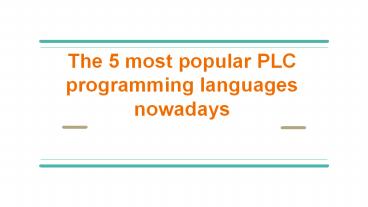The 5 Most popular PLC programming languages nowadays - PowerPoint PPT Presentation
Title:
The 5 Most popular PLC programming languages nowadays
Description:
In order to understand the types of PLC programming languages, it is necessary to understand the format and what constitutes the actual programming of a PLC. – PowerPoint PPT presentation
Number of Views:387
Title: The 5 Most popular PLC programming languages nowadays
1
The 5 most popular PLC programming languages
nowadays
2
How are PLCs programmed?
- Basically, the PLC program is an intermediate
link between the input and output devices
connected to the PLC. The following are the types
of PLC programming languages - Ladder diagram (LD)
- Function Block Diagram (FBD)
- Sequential Function Charts (SFC)
- Structural Text (ST)
- Instruction List ( IL)
3
Ladder diagram (LD) or the Ladder Logic Programs
- This is the most popular and preferred type of
PLC programming language. Since PLCs are
programmed with the basic relay logic, the ladder
logic uses simple normally open (NO) normally
closed (NC) and other lines of code instructions.
- One can actually witness the process logically
through the Rungs and data arriving as inputs
to the components of PLC.
4
Function Block Diagram (FBD)
- FBD programming language is used for multiple
repetitive functions like starters, closed-loop
control, PID loops, etc. Each component of the
FBD is connected to the preceding components
output. - In this, the data flows in a nested manner from
one block to the other virtually. The
identifiers, keywords, variables, and data types
need to be taken care of in this type of
programming.
5
Sequential Function Charts (SFC)
- The SFC similar to LD and FBD, and one of the
graphical programming languages for PLC. SFC is
used to write concurrent programs between steps
and transitions. These conduct actions based on
logical conditions. - This programming language has logic like that of
a flow chart. The program is divided into steps.
And, the steps can either be active or inactive.
6
Structural Text (ST)
- This programming is very similar to that of
high-level languages like Basic, Pascal, or C.
This is a great choice for implementing complex
algorithms and mathematical logic. It is very
easy to make modifications in this program as per
the standard format. - The common set of instructions in this
programming language are IF, WHILE, CASE, RETURN,
FOR, REPEAT, etc.
7
Instruction List ( IL)
- This is an assembly language type of PLC
programming language. It has a high level of
execution speed. As compared to others, IL has
very low memory consumption. It makes use of the
concept STACK. The mnemonic codes are usually
used for IL-based PLC programming likeANBORB - LDA
- ANI
8
In Conclusion
- PLCs have played a pivotal role in the automation
of various industries and deserve credit for the
same. The matter of deciding which PLC
programming language is the best for you depends
on the complexity of your problem at hand. Each
of these programming languages serves its own
unique purpose.
9
Contact Us
- Email info_at_narola.email
- Contact number 1 (650) 209-8400
- Website https//www.narolainfotech.com/plc-progra
mming-services
10
Thank You































